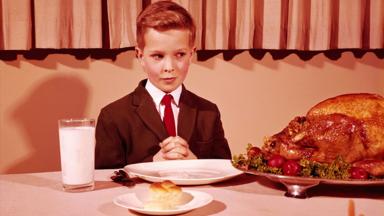THANKSGIVING DINNER
"Roast turkey and stuffing, lashings of cider applesauce, vegetables of every kind, mince pies and ‘plum-puddin'”: it’s all on the Thanksgiving menu at the New England home of Louisa May Alcott’s Bassett family. Published in 1881, An Old-Fashioned Thanksgiving is narrated by Jo, the bookish sister from Little Women, and needless to say the meal doesn’t quite go according to plan.
The day before, the Bassett parents are summoned away to tend grandma, who’s apparently on her last legs. Home alone, the children decide to cook their own Thanksgiving feast, which is how catnip and wormwood find their way into the stuffing, the turkey burns and the pudding turns out “as hard and heavy as one of the stone balls on Squire Dunkin's great gate”.
Happily, ma and pa return in the nick of time with news that grandma is just fine. There’s nothing to be done about that poor pudding but there is merriment, togetherness and gratitude. All in all, it’s a cosy reminder of what Thanksgiving is truly about, something folk were apparently apt to lose sight of even before Black Friday and rampant commercialisation warped the holiday’s meaning.

As writers from Shakespeare to Asterix creator René Goscinny have shown, celebratory meals come in handy as a literary device. They bring people together (and drive them apart), occasioning conversation (and stupendous quarrels), along with philosophical reflections on time’s passing. In such settings, ‘pass the salt’ can speak volumes about power struggles, illicit flirtations or long-nurtured grudges. The very menus can be equally eloquent, whether they’re a link to the past or an aspirational nod to the future. And of course food doesn’t have to be lavish to seem like a feast. The inhabitants of Tolkien’s Middle-earth knew plenty about fine dining but when Sam and Frodo have to sit down to cram – a sort of elven Ryvita – at the end of a long day’s questing, it doesn’t seem all that bad.
According to Tolkien, noshing on cram was “more of a chewing exercise” than actual eating, nutritious though it was. But sometimes it’s the descriptions of humbler meals that are most memorable, tapping as they do a set of scents and tastes familiar to many. Here’s the narrator of Moby Dick rhapsodising a steaming bowl of clam chowder: ‘Oh! sweet friends, hearken to me. It was made of small juicy clams, scarcely bigger than hazel nuts, mixed with pounded ship biscuits, and salted pork cut up into little flakes! the whole enriched with butter, and plentifully seasoned with pepper and salt’. If that has your tummy rumbling, you probably don’t want to be reminded about the sausages in The Silver Chair by CS Lewis – “spicy ones, fat and piping hot and burst and just the tiniest bit burnt”. Who but the creator of Narnia could make a sausage so magical? The perfect New York pretzel is what a lad in David Gilbert’s & Sons craves. You know the kind, and if you don’t, well here it is, “the dough toasted to perfection, the twist salted with a light, sticky snow…and don’t forget the lasso of mustard.” That pretzel is a tantalising mirage – it can be had from just one particular hot dog cart in Central Park, and when that cart cannot be found, the pretzel becomes only more delicious in its searcher’s memory, encapsulating the profound yearning that sits at the novel’s heart.
No comments:
Post a Comment